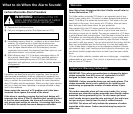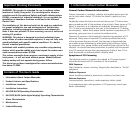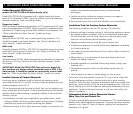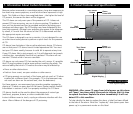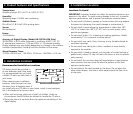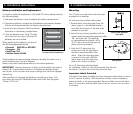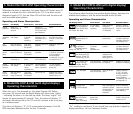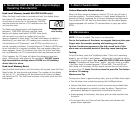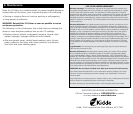
1. Information About Carbon Monoxide
Carbon Monoxide PPM Levels
(model KN-COPP-B-LPM with digital display only)
Model KN-COPP-B-LPM is equipped with a digital display that shows
levels of CO (displayed in PPM – parts per million). Learn the difference
between dangerous, high, mid and low levels.
Dangerous Levels:
When someone is experiencing symptoms of CO poisoning and CO read-
ings are generally above 100 PPM. Anytime someone is experiencing the
symptoms of CO poisoning this should be treated as an emergency. See
“What to do When the Alarm Sounds” (inside front cover).
High Levels:
Generally above 100 PPM, with no one experiencing symptoms. This
should be treated as an urgent situation. See “What to do When the
Alarm Sounds” (inside front cover).
Mid Levels:
Generally between 50 PPM to 100 PPM. This should be cause for concern
and should not be ignored or dismissed. See “What to do When the
Alarm Sounds” (inside front cover).
Low Levels:
Generally below 50 PPM. Kidde recommends you take action to eliminate
the source of CO. See “What to do When the Alarm Sounds” (inside
front cover).
IMPORTANT: Model KN-COB-B-LPM does not have a digital dis-
play and does not display carbon monoxide levels in PPM. If the
alarm sounds, it should be treated as a potentially serious condi-
tion. See “What to do When the Alarm Sounds” (inside front cover).
Possible Sources of Carbon Monoxide
Inside your home, appliances used for heating and cooking are the
most likely sources of CO. Vehicles running in attached garages can also
produce dangerous levels of CO.
CO can be produced when burning any fossil fuel, such as gasoline, pro-
pane, natural gas, oil and wood. It can be produced by any fuel-burning
appliance that is malfunctioning, improperly installed, or not ventilated
correctly, such as:
• Automobiles, furnaces, gas ranges/stoves, gas clothes dryers, water
heaters, portable fuel burning space heaters and generators, fireplaces,
wood-burning stoves and certain swimming pool heaters.
• Blocked chimneys or flues, back drafts and changes in air pressure, cor-
1. Information About Carbon Monoxide
roded or disconnected vent pipes, loose or cracked furnace
exchangers.
• Vehicles and other combustion engines running in an open or
closed garage, attached or near a home.
• Burning charcoal or fuel in grills and hibachis in an enclosed area.
Conditions That Can Produce Carbon Monoxide
The following conditions can result in transient CO situations:
• Excessive spillage or reverse venting of fuel-burning appliances caused
by outdoor ambient conditions, such as, wind direction and/or veloc-
ity, including high gusts of wind, heavy air in the vent pipes (cold/
humid air with extended periods between cycles).
• Negative pressure resulting from the use of exhaust fans.
• Simultaneous operation of several fuel-burning appliances competing
for limited internal air.
• Vent pipe connections vibrating loose from clothes dryers, furnaces, or
water heaters.
• Obstructions in, or unconventional, vent pipe designs which can
amplify the above situations.
• Extended operation of unvented fuel-burning devices (range, oven,
fireplace, etc.).
• Temperature inversions which can trap exhaust gases near the
ground.
• Vehicle idling in an open or closed garage, or near a home.
To be safe, know the possible sources of CO in your home. Keep fuel-
burning appliances and their chimneys and vents in good working
condition. Learn the early symptoms of exposure, and if you suspect CO
poisoning, move outside to fresh air and get emergency help. Your first
line of defense is an annual inspection and regular maintenance of your
appliances. Contact a licensed contractor or call your local utility com-
pany for assistance.
Information About Carbon Monoxide Alarms –
What They Can and Cannot Do:
CO alarms provide early warning of the presence of CO, usually before a
healthy adult would experience symptoms. This early warning is possible,
however, only if your CO alarm is located, installed and maintained as
described in this guide.




